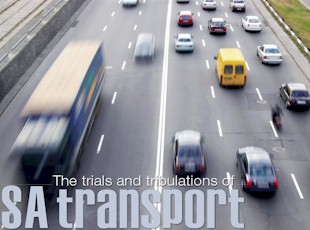The trials and tribulations of SA transport

This year’s Institute for Road Transport Engineers’ (IRTE) AGM revealed two key truths about South Africa’s transport industry: the winds of change are upon us, and the local transport fraternity does not necessarily welcome them. NADINE VON MOLTKE reports
Annual conferences and AGMs tend to be a good marker of the issues currently affecting the industry at hand. In the case of the IRTE’s AGM, the two topics covered by guest speakers were cross-border transport and AARTO, South Africa’s new traffic control system.
Cross-border transport has always brought with it a number of pitfalls, and for those involved in this area of commercial transport, changes dealing with these issues are welcome. Not so with AARTO.
While a system that finally addresses road safety in South Africa should be welcomed, it appears the exact opposite is happening.
Road users are already concerned about the implications of AARTO, i.e. point demerits and a new fine system, but it is operators that stand to lose the most – if they do not comply with the law.
The guest speaker of the evening whose presentation centred on AARTO was Alta Swanepoel, director of Alta Swanepoel and Associates and a traffic and transport consultant, who was instrumental in the formulation of the legislation surrounding the new system.
While the entire AGM was interested in AARTO and how it works – particularly as information pertaining to it has been scarce – it was not until Swanepoel began addressing the exact implications of various infringements on operators that delegates sat up and took notice.
Perhaps taking ‘notice’ is too euphemistic. Dai Davies, IRTE’s chairman, needed to call the room to order three times in order for Swanepoel to be heard over the ruckus.
CROSSING BORDERS
But let’s return to cross-border issues before jumping into the eye of the AARTO storm. According to Barney Curtis, executive director of the Federation of East and Southern Road Transport Associations (FESARTA), cross-border transport is a R3-billion-per-annum industry in the Southern African Development Community (SADC) region alone.
In addition to this, SADC has publicly stated that its aim is to grow intra-regional trade from 20 to 58% of the region’s gross domestic product (GDP), which means a huge boost to cross-border transport.
However, as any operator involved in this sector of the transport industry will confirm, carrying loads across two or more countries is complicated, expensive, time consuming and dangerous.
“There are a number of key issues that FESARTA is currently addressing,” revealed Curtis. “One of these is cheap, unroadworthy, foreign trucks entering South Africa. They pose a huge safety threat to local road users and road authorities are simply not tough enough on them.”
In response to this issue, SADC has entered discussions for a protocol stipulating harmonised law enforcement in which all member states agree to abide by certain fixed standards of vehicle roadworthiness.
“The problem is that it’s a very slow process,” said Curtis. “When multiple regions are involved, we always need more patience.”
The main issue in cross-border transport is time-based, though. Simply put, it is extremely time consuming, and time is money. Some of the issues involved include overextended border posts, poor roads and no universal overloading limits. For example, Beit Bridge, the busiest border in Africa, cannot cope with the traffic it encounters each day. According to Curtis, more than 600 trucks pass through it daily, resulting in queues stretching for many kilometres.
Overloading is also a problem. No two countries have the same overloading limits. The result is trucks that are weighed multiple times along the route, or that are travelling underloaded according to South African tolerances, because another country they pass through has much lower limits.
“FESARTA is currently involved in working towards a universal load limit across the region,” explains Curtis. “If ministers can agree on one limit, trucks will only need to weigh in once at the start of their journey. Imagine the time saved.”
Deteriorating roads also pose huge problems, more so across the border than within South Africa. Regional Aid For Trade (RTFP) has pledged US$1.2 billion (R9.2 billion) to improve and upgrade the north-south corridor running from Durban to the Democratic Republic of the Congo (DRC), although the process will be slow.
“Last week I was emailed a photo of a section of this corridor that had literally collapsed,” said Curtis. “This is hardly conducive to intraregional trade, particularly when there is no real alternative to this corridor.”
Cross-border transport certainly has its pitfalls, although SADC, FESARTA and a number of other affected bodies are working hard to streamline the process. However, while operators involved in this sector of the industry might be pulling out their hair more than most, these issues do tend to be par for the course. AARTO, on the other hand, elicits an extreme reaction.
AARTO AWARENESS
The first problem appears to be a complete lack of information pertaining to AARTO and how it will influence operators. Alto Swanepoel is available to all companies wishing to receive a presentation on the new system, but for the most part, understanding is sketchy.
Without detailing how the system differs from the previous one, or highlighting the differences between an administrative and a criminal system, here are the bones of AARTO and how it will affect operators:
First, both operators and drivers are accountable for the state of their vehicles. For example, if a truck is found to have bald tyres, the driver will receive a fine of R500, and the operator will receive an additional fine of R1 250.
“The legislation states that, as an owner of the vehicle, one must firstly always know who is driving the vehicle, and secondly always be aware of the state of the vehicle,” explained Swanepoel. “So, if anything is amiss, as an operator you are directly responsible.” In addition, there are demerit points to be received. Drivers, individual vehicles and fleets are able to accumulate demerits individually. So, an infringement worth four demerit points will be added to the driver’s personal balance, the vehicle, as well as the fleet.
While three months of perfect driving will result in the subtraction of one demerit for all three again, other vehicles and drivers in the fleet accumulating points could still result in an entire fleet being grounded.
According to section 49 of AARTO, which deals with the duties of operators, all fleets have a maximum number of demerit points which they can accumulate. A fleet of 19 vehicles can accumulate 228 points; 40 can accumulate 460 points; 71 can accumulate 759 points and 120 can accumulate 1 140. Any points received thereafter ensures the grounding of the entire fleet.
In a fleet of 120 vehicles, each vehicle can accumulate 9.5 demerit points before the entire fleet is grounded. If 87 vehicles (or 73% of the fleet) accumulate the maximum demerits, the entire fleet is also grounded. If an individual vehicle is grounded, it returns to full service a month later with 12 points – and will only lose one point three months later if a perfect record is maintained. Demerits range from one to four points, depending on the infringement. It is therefore much easier to gain demerits than lose them, and they stack up far faster than operators can get rid of them again.
So, while a system of earning back points might work for individual vehicles and drivers, operators need to be far more in control of their fleets. They quite literally cannot afford even minor infractions.
While a grounded vehicle is bad enough, an entire fleet grounded for one whole month quite possibly means the end of a business. In addition, an operator whose fleet is grounded and card suspended cannot buy a new vehicle.
Operators hearing this at the IRTE’s AGM were naturally shocked. The implications are extensive. However, while the fear associated with any new system – particularly one as strict as AARTO – is perfectly natural, one has to wonder what exactly everyone is so scared of.
The transport industry repeatedly laments the state of road safety in South Africa. A system forcing operators and drivers to comply with legislation can only help this. “AARTO only comes to you if you do something wrong,” pointed out Swanepoel, and her point is a valid one.
Unfortunately, AARTO follows a system of ‘guilty until proven innocent’ by necessity. According to Swanepoel, the decision was taken that it was easier for individuals to prove their innocence than for the state to prove the guilt of each infringer.
Jim Campbell, IRTE technical committee chair, commented that such a system is not easy to readily accept. However, assuming that AARTO is not out to damage the industry, but improve it, compliant operators should have no problem.
Published by
Focus on Transport
focusmagsa




